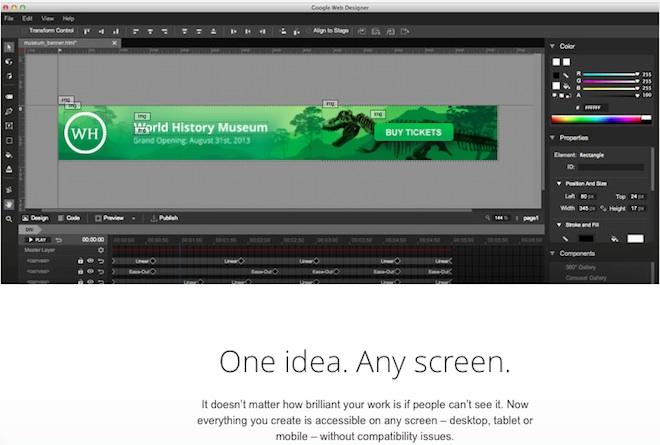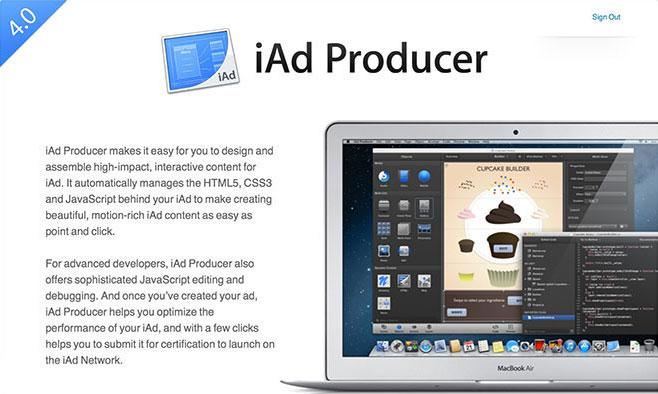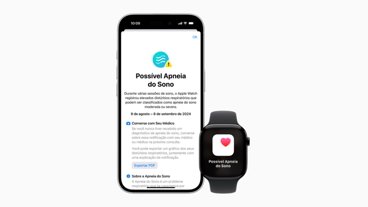Three years after Apple launched iAd Producer as a way to build interactive ads and other content using HTML5, JavaScript and CSS web standards, Google has launched a beta development tool of its own, which it calls Web Designer.
Google announced its plans earlier this year, but has now launched its first Web Designer Beta, to "create engaging, interactive HTML5-based designs and motion graphics that can run on any device."
The tool is designed primarily to create advertising "through any platform" the company notes, naming its own DoubleClick Studio and AdMob ad networks, but also providing a "generic option to push content through any other ad network."
Google's Flash gets the pan
The company specifically highlights the new tool's web standards as working on "any screen," noting "it doesn’t matter how brilliant your work is if people can’t see it. Now everything you create is accessible on any screen – desktop, tablet or mobile – without compatibility issues."The fate of Flash on Android turned out to be very similar to the fate of WebM and NFC.
That's a clear allusion to Google's previous efforts to push Adobe Flash as a desktop medium for web ads into the mobile space. The company wasted years in a failed attempt to port Flash to Android as a differentiating feature, and spent lots of resources promoting the idea that iOS was lacking support for Flash playback, before being forced to acknowledge that without iOS, there was no market.
Android ended up with experimental Flash support that never worked on most devices, and didn't last for more than a single Android dessert name before it was terminated with the release of Jelly Bean two years ago. The fate of Flash on Android turned out to be very similar to the fate of WebM and NFC.
Apple & iAd Producer
Apple addressed the primary potential use cases of Flash on iOS initially by working with video producers (including Google's YouTube) to support standard H.264 video for mobile playback, rather than continuing to use the proprietary codecs and wrapping of Flash Videos that had become a de facto standard on the web.
The company next began targeting interactivity and ads with initiatives and tools designed to replace Flash with open web standards: HTML5, JavaScript and CSS. However, by that time Google had shifted from a key Apple partner to a combative opponent.
After relaunching Android 2.0 as an iPhone clone, Google tried to block Apple from entering the mobile ad market by paying an astronomical $750 million to acquire AdMob, then in talks with Apple, which subsequently paid just $275 million to buy Quattro Wireless instead.
The next year, as Google turned its back on open source and web standards by making Android 3.0 closed source and throwing its support behind Flash rather than HTML5 and H.264, Apple's Steve Jobs outlined plans for iAd in iOS 4, designed to fix the problems in mobile advertising by making ads interactive and unobtrusive, and built using web standards.
By the end of the year, Apple released iAd Producer as a development tool for creating iAd content, as AppleInsider had projected that summer.
Since then, Apple has added support for building other web-standards content to iAd Producer, this spring launching version 4.0 supporting development of interactive iBooks Author widgets, iTunes LP liner notes and iTunes Extra DVD-like bonus content for movies.
And while the media and analysts have tirelessly sought for years to spread the notion that iAd was a huge failure headed for certain doom, Apple itself has been hiring teams of new iAd staff and has expanded the program outside of interactive web ads sponsoring apps to also include audio and video segments that support the new iTunes Radio.
A report by eMarketer in June projected revenue growth for Apple's iAd to reach $213 million this year, increasing to $376 million in 2014 and $623 million in the following year, a compounded annual growth rate of 71.3 percent.
Earlier this month, a report by Ad Age noted that Apple lined up major advertisers for its iTunes Radio launch, including McDonald's, Nissan, Pepsi and Procter & Gamble.
These top brands "paid upwards of $10 million to be exclusive iTunes Radio advertisers within their respective industries through the end of 2013," the magazine reported, adding that Apple is also "readying iTunes Radio — and its new ad products — for its wide launch to advertisers at the start of 2014."
 Daniel Eran Dilger
Daniel Eran Dilger








-m.jpg)






 Wesley Hilliard
Wesley Hilliard
 Malcolm Owen
Malcolm Owen
 Andrew Orr
Andrew Orr
 William Gallagher
William Gallagher
 Sponsored Content
Sponsored Content
 Christine McKee
Christine McKee

 Thomas Sibilly
Thomas Sibilly







32 Comments
Of course, google chases Apple. How do you think they've survived until now? With their stupid Ads $1 per click?!!! They've been copying Apple all along and those idiots at wall street thank them and jack up their stock price.
Wow that is really sweet. I'm totally impressed. This is sort of what we were expecting from Adobe. GWD rocks!
Check out the YouTube channel for tutorials.
http://www.youtube.com/googlewebdesigner
Thanks for the heads up, DED. I'll be sure to check out Google Web Designer.
The development of the iAd producer app has been nothing short of phenomenal. The early versions were not very useful but Apple persevered. That stick-to-it-iveness has really paid off. I was especially impressed with the iBooks Author widget feature.
"The fate of Flash on Android turned out to be very similar to the fate of WebM and NFC." Wah!? WebM and NFC are both alive and kicking. What are you talking about?